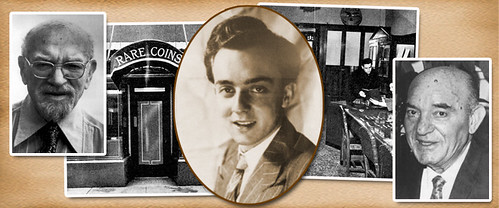
PREV ARTICLE
NEXT ARTICLE
FULL ISSUE
PREV FULL ISSUE
HARVEY STACK'S NUMISMATIC FAMILY, PART 6Harvey Stack's latest series in his Stack's Bowers blog focuses on growing up in a numismatic family. Here's part 6, published November 30, 2017. -Editor
 By 1943, the Chase National Bank had decided to disperse another part of the Col. E.H.R. Green collection of gold coins. Col. Green had been such a large buyer of anything he liked, that Chase Bank could not sell all he had at one time or it would overload the market. They might be accused of "dumping" large quantities of coins on the market all at once. When Chase went to sell items from the Green estate, they offered all his quarter eagles ($2.50 gold -- complete with few duplicates), a massive group of half eagles ($5 gold -- almost two full sets, and virtually hundreds of specimens from the 1795 to 1838 period) and a large group of eagles ($10 gold -- 1795 to 1907, and a full set of the Indian Head design, 1907 to 1933, with many duplicates). It took a lot of time to get the quantity of these we bought sorted by date and grade and to put them into stock. So even the junior Stack's were engaged to help. Examining all these coins provided a great opportunity to learn about these series, about scarcity, rarity, varieties, and how to judge quality. Hans M.F. Schulman, who had emigrated from the Netherlands to the United States in the early part of World War II, introduced us to the private secretary to King Farouk of Egypt. He was an avid collector of coins (especially gold), art, postage stamps, unusual jewelry and precious stones. In 1944 the private secretary told Hans that King Farouk wanted to try to get a full collection of United States gold coins. He felt that a collection of gold coins would show his regard for all the United States did for Egypt, protecting it from the German Army during World War II. The coins from the Green Collection comprised a perfect offering to sell to King Farouk. We put together sets of quarter eagles, half eagles and eagles, made an offer and sold the sets intact to King Farouk. After the king's abdication in 1952 and the sale of his numismatic holdings in 1954 in Cairo, the coins of Col. Green appeared again. In that sale they were sold in large lots, rather than as single coins. A number of dealers from the United States attended the sale. Because of the size of each lot (both in quantity and in value) this sale was a great source for dealer inventory, as many of the lots were too large for most collectors to purchase for themselves. However, two well know collectors, John Jay Pittman and Gaston Di Bello, did attend the sale and acquired a good number of the coins they each needed for their collections. In 1945 another new collector entered the field, Clifford T. Weihman, who was the largest importer of olive oil in America. He decided to expand his collection of U.S. gold coins, after building a collection of world gold coins. We were able to show him, an incomplete set of United States $5 gold, 1795 to 1929, and a good collection of $10 gold 1795 t0 1933 from the Col. Green Collection. These were the second run Stack's had constructed from their original purchase of gold coins from that source. After we made these two major sales to Farouk and Weihman, we still had in our inventory a large selection of dates and mints of the $5 and $10 gold, which we offered to collectors at private sale and at public auction. To read the earlier E-Sylum article, see:  Wayne Homren, Editor The Numismatic Bibliomania Society is a non-profit organization promoting numismatic literature. See our web site at coinbooks.org. To submit items for publication in The E-Sylum, write to the Editor at this address: whomren@gmail.com To subscribe go to: https://my.binhost.com/lists/listinfo/esylum All Rights Reserved. NBS Home Page Contact the NBS webmaster 
|